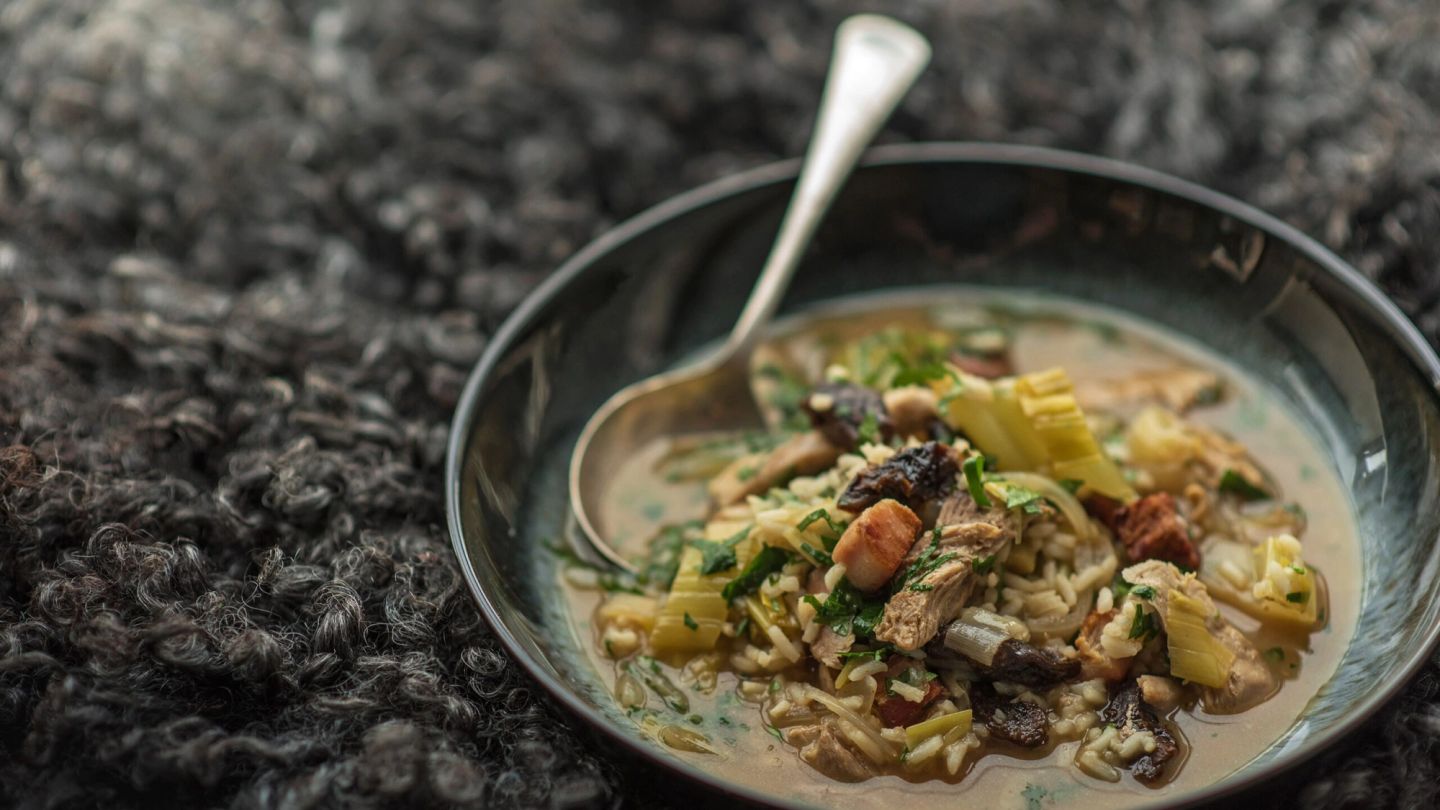

How to make Tom Kitchin’s ‘Pheasant Cock-a-Leekie’
We asked the Michelin-starred Scottish chef for a perfect, patriotic dish for Burns Night. Here’s what he suggested…
Words: Jonathan Wells
When Tom Kitchin won his first Michelin star in 2007, he became the youngest Scottish chef in history to be awarded the accolade. But that shouldn’t come as a surprise. With a surname as distinctive and delectable as Kitchin’s, surely it was predetermined that he’d don the whites and scoop up a saucepan?
Since opening his Edinburgh-based restaurant, The Kitchin, over 15 years ago, the Scottish chef has retained his hard-earned Michelin star every year. And Kitchin himself, a firm champion of fresh Scottish produce, is the perfect person to introduce you to the outlandish and often eyebrow-raising cuisine of this wild and woolly nation. So what dish will make the best first impression?
“Cock-a-leekie,” says Kitchin. “It’s one of the classic dishes of Scottish cooking – often referred to as Scotland’s national soup. Traditionally, it’s made with chicken, but I’m such a fan of game at this time of year that I’ve given it my own twist by swapping the chicken for pheasant”.
Cooking with game, Kitchin tells Gentleman’s Journal, is one of his passions — and he’s commonly asked how to prepare and serve these rich, characterful meats at home. “It’s far easier than you may think,” he says. “And swapping pheasant for chicken in some of your favourite recipes is actually a great way to start. I always say that if you can cook a chicken, you can cook a pheasant!”
At The Kitchin, where the ever-evolving menu currently includes game from hare to roe deer, meats are delivered in furs and feathers — and the team does its own butchering in-house.
“For me, those preparations are all part of the process of really understanding the produce and how best to enjoy it, but I understand that’s not for everyone,” acknowledges Kitchin. “It can take people out of their comfort zone — but that’s when cooking gets really exciting! However, if you are nervous about preparing the bird yourself, you can always ask your local butcher to help you out.”
“If you can cook a chicken, you can cook a pheasant!"
So why pheasant? What makes this dish the perfect gamey gateway into the world of Scottish cuisine — ahead of haggis, or the equally popular, much fishier soup, ‘Cullen skink’?
“As with most game birds,” says Kitchin, “you can use absolutely every part of the pheasant in your cooking; whether it’s picking all the leftover meat from the bone to make into a stew or casserole, or using the bones to make a wonderful pheasant stock.
“With this recipe,” he adds, “I really recommend that you don’t cut any corners by not adding the prunes, as they work fantastically well with the pheasant. Because this a proper ‘do you good’ soup that will warm you up — and keep you going throughout the day…”
How to make Tom Kitchin’s Pheasant Cock-a-Leekie (serves 4)

Ingredients:
- 1 oven-ready pheasant (about 600g) cut into pieces
- Olive oil
- 150g smoked lardons
- 2 celery sticks, chopped
- 2 leeks, trimmed, sliced and rinsed
- 2 onions, chopped
- 100ml dry white wine
- 1.5 litres of water
- 1 bouquet garni
- 200g basmati rice
- 100g prunes, halved and stoned to serve
- Chopped plat leaf parsley, to garnish
- Salt and freshly cracked black pepper
Method:
- Pat the pheasant pieces dry, then season them with salt and pepper. Heat a large heavy-based saucepan over a medium heat, then add a good splash of oil. When it is hot, add the pheasant pieces and sauté for 2-3 minutes until they are starting to colour. Remove them from the pan and set aside.
- Reheat the pan with any remaining fat. Add the lardons and sauté until they render their fat and are coloured all over. Stir in half of the celery, leeks and onions, and continue sauteing for 2-3 minutes until they are beginning to colour and soften. Add the wine, stirring to deglaze the pan, and boil until it evaporates.
- Return the pheasant pieces to the plan with the water and bouquet garni. Add extra water, if necessary, so all the ingredients are submerged. Slowly bring to the boil, skimming the surface. Reduce the heat to low, season with salt and pepper, partially cover and leave to simmer for 40-45 minutes until the pheasant breasts are tender and the broth is flavoursome.
- Meanwhile, rinse the rice under cold running water until the water runs clear, then set aside.
- Strain the broth through a chinois or fine sieve, then return it to the washed pan. Set the pheasant pieces aside, and discard the flavouring vegetables, lardons and bouquet garni.
- Bring the broth to the boil, add the rice and remaining celery, leek and onion, and leave to lightly boil for 8-10 minutes until the rice and vegetables are tender, adding extra water if necessary.
- When the pheasant pieces are cool enough to handle, remove the skin and pull the meat from the bones, tearing into bite size pieces. (Keep the carcasses to make a stock. If you don’t want to do that immediately, the bones can be frozen until you’re in the mood or have time.) Once the rice and vegetables are tender, return the pheasant meat to the broth to gently reheat. Adjust the seasoning with salt and pepper.
- When ready to serve, stir in the prunes, heat through, then ladle into bowls and sprinkle with parsley.
Want more great dishes? Here’s Russell Norman’s recipe for anchovies and butter…
Become a Gentleman’s Journal member. Find out more here.


